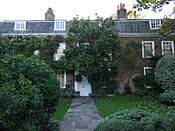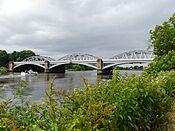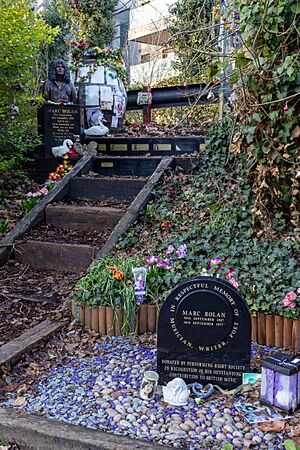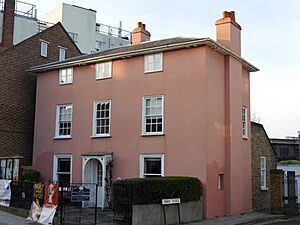Barnes, London facts for kids
Quick facts for kids Barnes |
|
|---|---|
 The Terrace on Barnes riverside from Barnes Bridge |
|
| Area | 4.50 km2 (1.74 sq mi) |
| Population | 21,218 (Barnes and Mortlake and Barnes Common wards 2011) |
| • Density | 4,715/km2 (12,210/sq mi) |
| OS grid reference | TQ225765 |
| • Charing Cross | 5.8 mi (9.3 km) ENE |
| London borough | |
| Ceremonial county | Greater London |
| Region | |
| Country | England |
| Sovereign state | United Kingdom |
| Post town | LONDON |
| Postcode district | SW13 |
| Dialling code | 020 |
| Police | Metropolitan |
| Fire | London |
| Ambulance | London |
| EU Parliament | London |
| UK Parliament |
|
| London Assembly |
|
Barnes (/bɑːrnz/) is a cool area in south London, England. It's part of the London Borough of Richmond upon Thames. Barnes is located in a bend of the River Thames, about 5.8 miles (9.3 km) west of Charing Cross in central London.
This area is known for its shops and many old buildings from the 1700s and 1800s. These older streets around Barnes Pond are part of a special "conservation area." Along the river, you'll find the WWT London Wetland Centre, which is a huge nature reserve, and the Barn Elms playing fields.
Barnes has a walking path called the "Barnes Trail." It's a short circle that takes you along the river, through the shops, and past historic spots like the Olympic Studios. Silver discs on the ground and special oar signs with QR codes help guide the way. The Thames Path National Trail also runs along the river, which is part of the famous Championship Course used for rowing races.
You can get to Barnes by train, as it has two railway stations: Barnes and Barnes Bridge. Many bus routes also connect Barnes to central London and Richmond.
Contents
Getting Around Barnes
Barnes is in south west London. It's surrounded on three sides by a big curve in the River Thames.
Train Travel
Barnes doesn't have a London Underground (Tube) station. But it does have two National Rail stations, both in London's Travelcard Zone 3.
Local Train Stations
- Barnes railway station
- Barnes Bridge railway station
Trains from both stations are run by South Western Railway (SWR). They go east to Waterloo in central London, passing through Clapham Junction. You can also travel east to places like Chiswick, Brentford, and Hounslow. From Barnes station, trains also go southwest to Teddington and Kingston.
Barnes railway station is much busier than Barnes Bridge station. The closest other train stations are at Putney and Mortlake.
Tube Connections
To catch the Tube, you can go to nearby Hammersmith. There are two Tube stations there, serving four lines: the Circle and Hammersmith & City lines and the District and Piccadilly lines. From Hammersmith, you can easily reach the City and the West End. You can also get direct trains to Heathrow Airport.
Roads and Bridges
Barnes has two ways to cross the River Thames. Barnes Railway Bridge is a train bridge with a path for walkers next to it. Hammersmith Bridge is a suspension bridge built in 1887. It's currently closed to all cars because of structural problems. This closure affects people in Barnes who used to rely on it.
Many roads in Barnes are for homes, but some main roads pass through the area. These roads carry traffic across London and South East England.
The South Circular Road (A205) goes through the southern part of Barnes. It takes traffic east towards Wandsworth and the City of London. Going west, it leads towards Richmond and the M3 motorway, or to the M4 motorway. The A306 runs north and south through Barnes. Going north, it crosses Hammersmith Bridge towards Hammersmith. Going south, it connects to the A3 towards Guildford and Portsmouth.
Barnes High Street and Church Road form the A3003, which connects Barnes to nearby Mortlake.
Air Quality
The local council checks air pollution in Barnes. They measure things like nitrogen dioxide (NO2) and tiny particles (PM10). Air quality in Barnes has been getting better since 2011. The London Wetlands Centre has cleaner air than the main roads. However, Barnes High Street still has higher pollution levels.
Buses and Cycling
Barnes is served by several London Buses routes. The closure of Hammersmith Bridge has made it harder to get to Hammersmith by bus.
Two important cycling routes go through Barnes:
- National Cycle Route 4 (NCR 4) – This route goes from Greenwich to Fishguard in West Wales. In Barnes, it uses a main road for a short bit. It offers a way to get to Waterloo via Putney and Chelsea. Westward, it goes through Richmond Park.
- London Cycle Network 37 – This route is part of an older network. It goes east towards Wandsworth and the City, or west towards Mortlake and Richmond.
You can cycle across the Thames in Barnes using either Hammersmith Bridge or Barnes Bridge (you need to walk your bike on the footpath).
River Thames Activities
The River Thames forms the northern border of Barnes. The Thames Path follows the riverbanks through the area.
Transport for London (TfL) runs riverboat services from nearby Putney Pier to Blackfriars on weekdays. This connects the Barnes area to places like Chelsea, Westminster, and the City. A summer boat tour also runs from Kew Pier to Westminster, or to Richmond and Hampton Court. These services do not stop directly in Barnes.
Nearby Places
 |
Chiswick | Hammersmith | Hammersmith |  |
| Mortlake Chiswick |
Fulham Putney |
|||
| East Sheen, Mortlake | Roehampton | Putney |
History of Barnes
Barnes is mentioned in the Domesday Book of 1086, where it was called "Berne." It was owned by the Canons of St Paul's of London.
In 1889, Barnes became part of the Municipal Borough of Barnes. Later, in 1965, it became part of the London Borough of Richmond upon Thames.
Famous Buildings
The original part of St Mary's, Barnes' village church, was built between 1100 and 1150. It was made bigger in the early 1200s. In 1215, after signing the Magna Carta, Stephen Langton, the Archbishop of Canterbury, stopped at Barnes to dedicate St Mary's church. The church was added to in 1485 and 1786. A big fire in 1978 destroyed some newer parts, but it was rebuilt by 1984.
Some of London's oldest riverside homes are on The Terrace. This road has beautiful Georgian mansions, with construction starting as early as 1720. Famous people like Gustav Holst and Ninette de Valois lived here, and their homes have special blue plaques. The Terrace also has an old red brick police station from 1891, which is now apartments but still looks original.
The pink-fronted Rose House near Barnes Pond is from the 1600s. Milbourne House, facing the Green, is the oldest house in the area, with parts from the 1500s. It once belonged to writer Henry Fielding. Barn Elms, which used to be a manor house, is now an open space and playing field. It has one of London's oldest and largest London Plane trees, known as a "Great Trees of London."
The Barnes Railway Bridge, built in 1849, is a Grade II listed building. It stands out when you look at the river from The Terrace.
Castelnau, in north Barnes, has a small church called Holy Trinity. The area between Castelnau and Lonsdale Road has a 1930s housing estate, mostly built by the Henry Boot company.
Local Shops and Businesses
A survey in 2014 found that Barnes had the highest number of independent shops in Britain, at 96.6%. This means most shops in Barnes are unique and not part of big chains.
Nature and Green Spaces
Barnes Common is a large open space and a local nature reserve. It covers about 120 acres (0.49 km²) and makes Barnes feel like a countryside village. It has different habitats like acid grassland, bushes, woods, and wetland. Beverley Brook flows through part of the common before joining the Thames.
In 2001, Barnes Pond suddenly emptied overnight. No clear reason was found, but it was later fixed and improved with help from the local council and community.
The Barn Elms reservoirs were turned into a wetland habitat and bird sanctuary in 1995. This area, now the WWT London Wetland Centre, has open water, grazing marsh, and reed beds. It's a very important place for birds, especially for shovellers and teal in winter.
Landmarks and Fun Things to Do
The Barnes Trail is a 2.3-mile (3.7 km) circular walk that opened in 2013. It has a newer part along the riverside with QR codes for information. This part is a wide path with old Victorian houses and green spaces.
The spot where rock musician Marc Bolan had a fatal car crash in 1977 is now Bolan's Rock Shrine. Fans often visit this memorial. In 1997, a bronze statue of Bolan was placed there. In 2007, the English Tourist Board called it a "Site of Rock 'n' Roll Importance."
Olympic Studios on Church Road is an independent cinema. It shows both new movies and art films. It used to be a local cinema and then a very famous recording studio. Many legendary music stars recorded there.
In 1967, the Beatles came up with ideas for "All You Need Is Love" at Olympic Studios. This song was later shown to millions worldwide on Our World, the first global satellite broadcast.
The Rolling Stones visited so often that Mick Jagger helped design parts of the studio. Jimi Hendrix also recorded many songs for his albums there. Led Zeppelin recorded their first album and other music at the studio from the late 1960s to the mid-1970s. Other famous artists who recorded there include The Who, Queen, Pink Floyd, David Bowie, Adele, and Madonna.
The Bull's Head pub, facing the Thames, was one of the first jazz venues in Britain. It still hosts live music in a special room for up to 80 people.
The OSO Arts Centre opened in 2002. It's a place for art shows and fringe theatre (smaller, experimental plays). It used to be a postal sorting office.
The area around Barnes Pond hosts several markets each month. Barnes Green is where the Barnes Fair is held every year on the second Saturday of July. It's organized by the Barnes Community Association (BCA), whose office is at Rose House, the distinctive pink building on Barnes High Street.
Since 2015, Barnes Pond has been home to the Barnes Children's Literature Festival. It's London's biggest event for children's books and the second largest in Europe!
Places to Worship

Barnes has seven churches:
- Barnes Baptist Church
- Barnes Healing Church (Christian Spiritualist)
- Barnes Methodist Church
- Catholic Church of St Osmund, Barnes
- Holy Trinity Barnes (Church of England)
- St Mary's Church, Barnes (Church of England)
- St Michael and All Angels Church, Barnes (Church of England)
Local Societies
| Abbreviation | BMHS |
|---|---|
| Formation | 1955 |
| Founder | Maurice Cockin |
| Legal status | registered charity (number 292918) |
|
Region served
|
Barnes, Mortlake and East Sheen |
|
Membership
|
400 |
|
Chairman
|
Paul Rawkins |
|
Main organ
|
Barnes and Mortlake History Society Newsletter (four times a year) |
|
Budget
|
£5.6k |
|
Staff
|
none |
The Barnes and Mortlake History Society was started in 1955. It helps people learn about the local history of Barnes, Mortlake, and East Sheen. The society holds talks and activities about history and publishes a newsletter four times a year.
Sports in Barnes
Football History
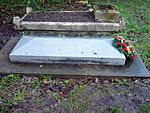
Barnes has an important place in the history of football. A former headmaster of St Paul's School, Richard Mulcaster, helped turn "mob football" into an organized team sport. St Paul's School is now in Barnes.
Barnes was also home to Ebenezer Cobb Morley. In 1862, he helped start the Football Association (FA). In 1863, he suggested creating a governing body for football. This led to the first meeting where the FA was formed. He was the FA's first secretary and wrote the first rules for modern football at his home in Barnes. These rules were adopted by the FA and spread worldwide. He even played in the first game using these new rules. Many consider Morley the "father of football" because of his key role in creating modern association football.
Rugby
Barnes Rugby Football Club's ground, called Barn Elms, is right next to the WWT London Wetlands Centre.
Rowing
The curve of the Thames around Barnes is part of the Championship Course. This course is used for the famous Oxford and Cambridge Boat Race and other big rowing competitions. Three rowing clubs are across Barnes Bridge. A statue of Steve Fairbairn, who changed rowing techniques, is by the river near the London Wetlands Centre.
Images for kids
-
Entrance to the visitors centre at the WWT London Wetland Centre; on the left is the statue of Peter Scott by Nicola Godden
-
Marc Bolan's shrine, on what would have been his 60th birthday, 30 September 2007
-
Barnes Pond with the Sun Inn in the background
-
The Barn Elms London Plane tree known as "Barney", thought to be the oldest example of the species in London and officially designated a "Great Tree of London"
See also
 In Spanish: Barnes (Londres) para niños
In Spanish: Barnes (Londres) para niños




